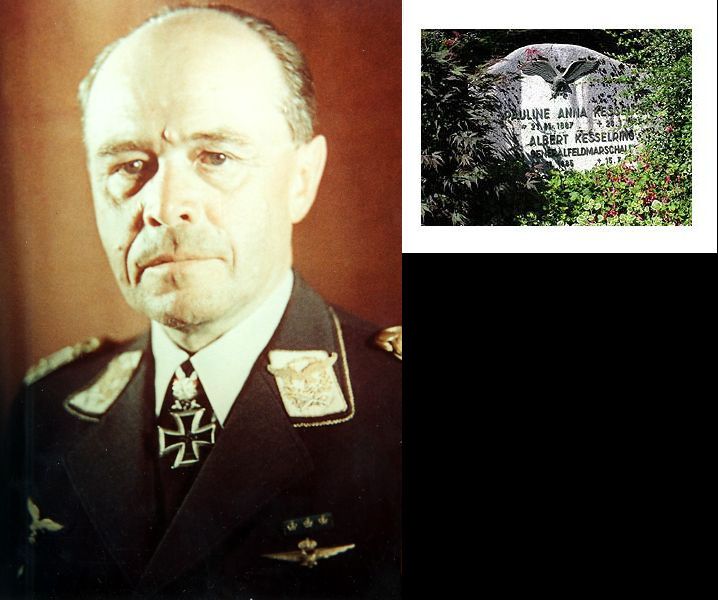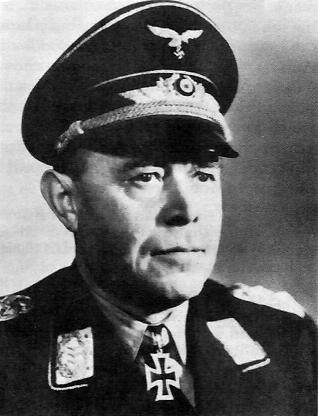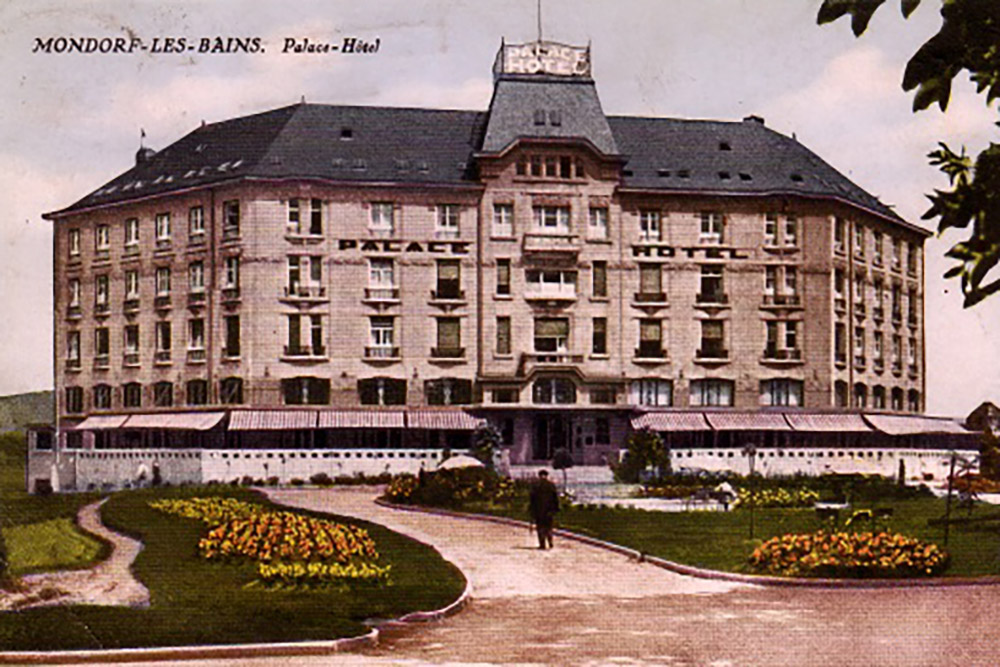Kesselring, Albert
- Date of birth:
- November 30th, 1885 (Marktsheft/Bavaria, Germany)
- Date of death:
- July 16th, 1960 (Bad Nauheim/Hesse, Germany)
- Nationality:
- German
Biography
Born in Marktsheft, Bavaria on November 20th, 1885, Albert Kesselring joined the army as a Cadet in 1904 and rose to artillery officer. After WW I he transfered to the Reichswehr and in 1932 became Brigadier of an artillery regiment
In 1935 he transfered to the young Luftwaffe and rose quickly through the ranks; from June 6th, 1936, to May 31st, 1937, he served as Chef des Generalstabes der Luftwaffe (Chief of General Staff of the Air Force), following this he was promoted to General der Flieger and to Oberbefehlshaber Luftflotte I in 1938.
In this capacity he served in Poland. He rose to become the service's most powerfull and important officer after Hermann Göring, Hitler's appointed deputy and the Luftwaffe's Commander in Chief. During the Battle of Britain in 1940, he was in charge of the principal German airfleet that came very close to defeating the RAF.
In 1942 Kesselring was promoted to Field Marshall and appointed Commander in Chief South with overall responsability for all German operations in the Mediterranean region; he worked closely with Rommel in the North-African campaign and his unique understanding of both air and ground forces enabled him to coordinate their use properly, achieving results sometimes quite out of proportion to his limited resources. In Italy, commanding both ground and air forces, he conducted a faultless campaign, gradually withdrawing northwards and exacting a huge price for every Allied gain.
March 23rd, 1944 partisans carried out on a bomb attack on a German barracks in Rosella Street, Rome. From Berlin, the Führer issued an order and Kesselring passed it down that 10 Italians should be shot in reprisal for every German killed. As a result, on March 24th, 335 Italians were executed in what became known as the Ardeatine Cave massacre. After the war, Kesselring was charged with responsability for these killings and in 1947 appeared before a British court in Venice which subsequently sentenced him to death.
However, this sentence was changed to life imprisonment but he was released in October 1952 due to his failing health. He died in Bad Nauheim, Germany on July, 16th 1960.
For his services during World War One, Albert Kesselring received the Kgl. Bayer. Prinz-Regent-Luitpold Jubiläums-Medaille, the Kgl. Bayer. Militär-Verdienstorden IV Klasse mit Schwertern, the Ritterkreuz II Klasse des kgl. Sächs. Albrechts-Ordens mit Schwertern and the Kgl. Bayer. Militär-Verdienstorden IV Klasse mit der Krone und Schwertern.
Promotions:
February 4th, 1904: Fähnrich;
March 8th, 1906: Leutnant;
October 25th, 1913: Oberleutnant;
May 19th, 1916: Hauptmann;
April 1st, 1925: Major;
February 1st, 1930: Oberstleutnant;
October 1st, 1932: Oberst;
October 1st, 1934: Generalmajor;
April 1st, 1936: Generalleutnant;
October 1st, 1938: General der Flieger;
June 1st, 1937: General der Flieger;
July 19th, 1940: Generalfeldmarschall.
Career:
July 20th, 1904 - September 30th, 1912: 2. bayerische Fußartillerie-Regiment;
March 1st, 1905 - January 25th, 1906: Kriegsschule, München;
October 1st, 1908 - March 18th, 1910: Pionier- und Artillerieschule;
June 4th, 1912 - June 22nd, 1912: Ballonbeobachter bayerisches Transport-Bataillon;
October 1st, 1912 - December 4th, 1914: Adjutant I. Bataillon, 2. bayerische Fußartillerie-Regiment;
December 5th, 1914 - March 12th, 1915: Adjutant 1. bayerische Fußartillerie-Regiment;
March 13th, 1915 - May 7th, 1915: Staboffizier 1. bayerische Fußartillerie-Brigade;
May 8th, 1915 - September 2nd, 1915: Adjutant I. Bataillon, 2. bayerische Fußartillerie-Regiment;
September 3rd, 1915 - March 5th, 1917: Staboffizier 1. bayerische Fußartillerie-Brigade;
March 6th, 1917 - November 23rd, 1917: Adjutant bayerische Artillerie Kommandeur 3;
October 8th, 1917 - October 23th, 1917: Kursus, Berlin;
November 24th, 1917 - January 3rd, 1918: Generalstabsoffizier, Stab 2. bayerische Division;
Janbuary 4th, 1918: Generalstab III. bayerisches Armeekorps;
January 6th, 1918: Generalkommmando 6;
April 15th, 1918 - August 23rd, 1919: Generalstab III. bayerisches Armeekorps;
August 24th, 1919 - October 20th, 1919: Batteriechef 24. Artillerie-Regiment;
October 21st, 1919 - November 7th, 1919: Stab 24. Artillerie-Regiment;
November 8th, 1919 - December 31st, 1920: Batteriechef 24. Artillerie-Regiment;
January 1st, 1921 - September 30th, 1922: Batteriechef 7. Artillerie-Regiment;
October 1st, 1922 - September 30th, 1925: Heeres-Ausbildungsabteilung (T 4), Reichswehrministerium;
October 1st, 1925 - September 30th, 1926: Stab, Chef der Heeresleitung;
October 1st, 1926 - March 31st, 1929: Reichswehrministerium;
April 1st, 1929 - May 4th, 1930: Stab 7. Division;
May 5th, 1930 - May 31st, 1930: Reichswehrministerium;
June 1st, 1930 - July 31st, 1930: Stab 3. Division;
August 1st, 1930 - January 31st, 1932: Heerespersonalamt;
February 1st, 1932 - September 30th, 1933: Kommandeur III. Abteilung, Artillerie-Regiment 4, Dresden;
October 1st, 1933 - May 1st, 1936: Leitung Amtes D, Reichsluftfahrtministerium;
June 3rd, 1936 - May 31st, 1937: Chef des Generalstabes der Luftwaffe;
June 1st, 1937 - February 3rd, 1938: Befehlshaber Luftkreis III, Dresden;
February 4th, 1938 - January 31st, 1939: Befehlshaber Luftwaffengruppenkommandos 1, Berlin;
February 1st, 1939 - January 11th, 1940: Oberbefehlshaber Luftflotte I;
January 12th, 1940 - June 26th, 1943: Oberbefehlshaber Luftflotte 2;
Janbuary 12th, 1940 - November 30th, 1941: Befehlshaber Nord;
December 2nd, 1941 - November 20th, 1943: Oberbefehlshaber Süd beim italienischen Oberkommando;
November 21st, 1943: Oberbefehlshaber Südwest / Oberbefehlshaber Heeresgruppe C;
October 23rd, 1944 - January 14th, 1945: Lazerett;
January 15th, 1945 - March 9th, 1945: Oberbefehlshaber Süd-West / Oberbefehlshaber Heersegruppe C;
March 10th, 1945 - May 1st, 1945: Oberbefehlshaber West;
May 2nd, 1945 - May 8th, 1945: Oberbefehlshaber Süd;
May 8th, 1945 - October 23rd, 1952: Gevangenschap.
Do you have more information about this person? Inform us!
- Period:
- Second World War (1939-1945)
- Rank:
- General der Flieger (Air Marshall)
- Unit:
- Chef, Luftflotte 1, Luftwaffe
- Awarded on:
- September 12th, 1939
- Period:
- Second World War (1939-1945)
- Rank:
- General der Flieger (Air Marshall)
- Unit:
- Chef, Luftflotte 1, Luftwaffe
- Awarded on:
- September 25th, 1939
- Period:
- Second World War (1939-1945)
- Rank:
- General der Flieger (Air Marshall)
- Unit:
- Chef, Luftflotte 1, Luftwaffe
- Awarded on:
- September 30th, 1939
3rd Luftwaffe Award.
- Period:
- Second World War (1939-1945)
- Rank:
- Generalfeldmarschall (Marshall of the AIr Force)
- Unit:
- Befehlshaber Nord
- Awarded on:
- October 8th, 1940
- Period:
- Second World War (1939-1945)
- Rank:
- Generalfeldmarschall (Marshall of the AIr Force)
- Unit:
- Befehlshaber Nord
- Awarded on:
- October 26th, 1940
- Period:
- Second World War (1939-1945)
- Rank:
- Generalfeldmarschall (Marshall of the AIr Force)
- Unit:
- Befehlshaber Nord
- Awarded on:
- November 9th, 1940
- Period:
- Second World War (1939-1945)
- Rank:
- Generalfeldmarschall (Marshall of the AIr Force)
- Unit:
- Befehlshaber Nord
- Awarded on:
- November 20th, 1940
- Period:
- Second World War (1939-1945)
- Rank:
- Generalfeldmarschall (Marshall of the AIr Force)
- Unit:
- Befehlshaber Nord
- Awarded on:
- November 25th, 1940
- Period:
- Second World War (1939-1945)
- Rank:
- Generalfeldmarschall (Marshall of the AIr Force)
- Unit:
- Befehlshaber Nord
- Awarded on:
- June 19th, 1941
- Period:
- Second World War (1939-1945)
- Rank:
- Generalfeldmarschall (Marshall of the AIr Force)
- Unit:
- Befehlshaber Nord
- Awarded on:
- August 6th, 1941
- Period:
- Second World War (1939-1945)
- Rank:
- Generalfeldmarschall (Marshall of the AIr Force)
- Unit:
- Befehlshaber Nord
- Awarded on:
- August 7th, 1941
- Period:
- Second World War (1939-1945)
- Rank:
- Generalfeldmarschall (Marshall of the AIr Force)
- Unit:
- Befehlshaber Nord
- Awarded on:
- September 19th, 1941
- Period:
- Second World War (1939-1945)
- Rank:
- Generalfeldmarschall (Marshall of the AIr Force)
- Unit:
- Befehlshaber Nord
- Awarded on:
- October 18th, 1941
- Period:
- Second World War (1939-1945)
- Rank:
- Generalfeldmarschall (Marshall of the AIr Force)
- Unit:
- Befehlshaber Nord
- Awarded on:
- October 19th, 1941
- Period:
- Second World War (1939-1945)
- Rank:
- Generalfeldmarschall (Marshall of the AIr Force)
- Unit:
- Oberbefehlshaber Süd, Wehrmacht
- Awarded on:
- February 25th, 1942
78th Award.
- Period:
- Second World War (1939-1945)
- Rank:
- Generalfeldmarschall (Marshall of the AIr Force)
- Unit:
- Oberbefehlshaber Süd
- Awarded on:
- June 17th, 1942
- Period:
- Second World War (1939-1945)
- Rank:
- Generalfeldmarschall (Marshall of the AIr Force)
- Unit:
- Oberbefehlshaber Süd, Wehrmacht
- Awarded on:
- July 18th, 1942
15th Award.
- Period:
- Second World War (1939-1945)
- Rank:
- Generalfeldmarschall (Marshall of the AIr Force)
- Awarded on:
- 1942
- Period:
- Second World War (1939-1945)
- Rank:
- Generalfeldmarschall (Marshall of the AIr Force)
- Unit:
- Oberbefehlshaber Süd
- Awarded on:
- September 10th, 1943
- Period:
- Second World War (1939-1945)
- Rank:
- Generalfeldmarschall (Marshall of the AIr Force)
- Unit:
- Oberbefehlshaber Süd, Wehrmacht
- Awarded on:
- July 19th, 1944
14th Award.
- Period:
- Second World War (1939-1945)
- Rank:
- Generalfeldmarschall (Marshall of the AIr Force)
- Unit:
- Oberbefehlshaber Süd, Wehrmacht
- Awarded on:
- 1944
- Period:
- Second World War (1939-1945)
- Period:
- First World War (1914-1918)
- Period:
- First World War (1914-1918)
- Period:
- First World War (1914-1918)
- Period:
- First World War (1914-1918)
- Period:
- First World War (1914-1918)
- Period:
- Second World War (1939-1945)
- Period:
- Second World War (1939-1945)
- Period:
- Second World War (1939-1945)
- Period:
- Second World War (1939-1945)
- Period:
- Second World War (1939-1945)
- Period:
- Second World War (1939-1945)
- Period:
- Second World War (1939-1945)
Sources
- Photo 1: Willi Schumacher/Norbert Beyerlein
- - FELLGIEBEL, W.P., Elite of theThird Reich, Helion & Company Limited, Solihull, 2003.
- KUROWSKI, F., Knight's Cross Holders of the Afrikakorps, Schiffer Publishing Ltd., Atglen, United States, 1996.
- THOMAS, FRANZ & WEGMANN, GüNTER, Die Eichenlaubträger 1940-1945, Biblio-Verlag, 1997.
- Kwasny A., Kwasny G., Die Eichenlaubträger 1940-1945 (CD), Deutsches Wehrkundearchiv, Lage-Waddenhausen, 2001
- Scherzer, V., Die Ritterkreuzträger 1939-1945 (2005)
- Wolff, Karl: Mit Wissen Hitlers. Meine Geheimverhandlungen über eine Teilkapitulation in Italien 1945 (2008)
- Die Wehrmachtberichte 1939-1945. 2 1. Januar 1942 bis 31. Dezember 1943
Photo
Background stories
The War Illustrated
- 07-'44: The Battle Fronts
- 07-'44: 5th and 8th Armies Advance on 150-Mile Front
- 11-'46: His Majesty's Ships - H.M.S. Aurora































